In a recent article on Forbes.com entitled 7 Ways You’re Hurting Your Daughter’s Future, the author cited the indoctrination of young girls into the ‘princess cult’ as a danger to the minds of future women. The article states that while real life princesses are often accomplished and well-educated, little girls are often taught that should she attract her prince through her looks or the proper application of a well-placed song and eyelash bat, all of her dreams will come true. It’s hard to miss what this article is pointing towards. The cult of princess is on every toy store in America, presented live in pink boxes everywhere for little girls to embrace. The Disney Princesses are a collection of characters meant to give little girls hours of play-time enjoyment. Yet the message behind many of the Disney princesses does seem to be the same: you may be resourceful, sweet, and kind, but in the end it was all for the sake of a happily ever after with your prince charming.
There are, however, a few wild cards within that Disney pantheon of princess-hood, female heroines that inspire lessons other than just matrimonial bliss. The latest installment in the ranks of what I like to call the Anti-Princesses is no other than Merida, the red-haired hellion from Brave. Yet she comes from a proud tradition of Disney women that bucked their place as just one half of a relationship to provide girls with a different view on feminine power.
The Non-Traditional Princesses

Before Merida rebelled against her mother’s view for her future and spoke up against her arranged marriage, there was Pocahontas. Forgetting what we know about Disney’s rewrite of the Pocahontas story, this animated Native American was the ultimate princess at the cusp of change in her life. Presented with the option to marry a super-serious warrior or keep looking for signs to her future, Pocahontas risked it all to be a bridge between her people and the English settlers, led by her love interest John Smith. This film adaptation of quasi-historical events presented girls with a pro-active heroine willing to turn away tradition to see the big picture for her people. Pocahontas is the focal point of her own story, which revolves around personal bravery and responsibility within one’s community. When she is asked to leave with John Smith for England, Pocahontas chooses to stay with her people and eschew her ‘true love’ as a personal act of sacrifice and mature responsibility. In a culture where stories are often so love-plot centric, this sets Pocahontas apart from the others as a strong, independent role-model for young women.
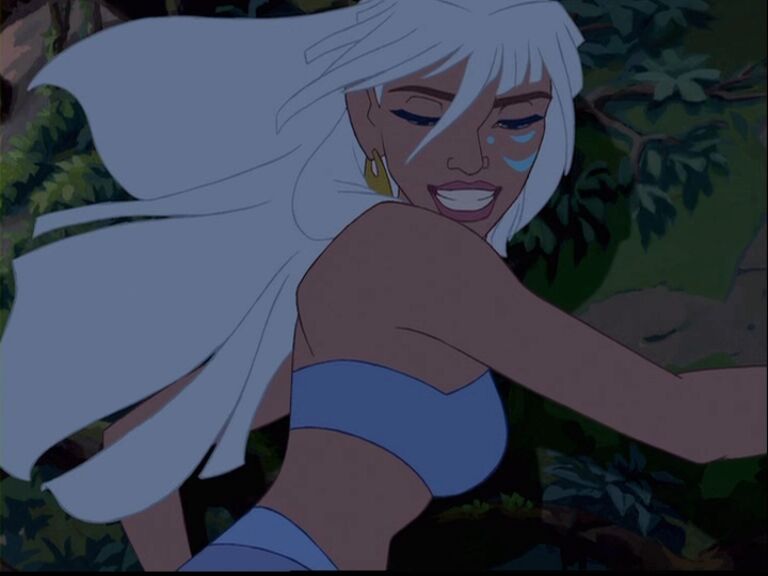
Another example of this non-traditional princess is Kida from Disney’s Atlantis. Though she is thwarted by becoming the traditional ‘damsel in distress’ towards the end of the film, Kida is a combat ready nigh-immortal Atlantean princess who defies her father to try and rescue her people. She shows the same tenacity, responsibility, strength and wit that are hallmarks of Disney Princesses and yet she, unlike Pocahontas, is cut out of the princess line-up. Maybe the whole spear-wielding fighter thing doesn’t jive with the ‘singing to twittering birds and wearing gowns’ set? Who knows, but Kida proves herself just as much of a princess as she outthinks, outfights and outshines almost every other woman in the lineup. Maybe all she’s missing to make the cut is a pretty gown.
These two princesses are examples of royals making good on their responsibility to their position while still taking charge of their story in a way that informs the forward-thinking Princess Merida. Yet there are non-royal princesses that also stand as part of the Anti-Princess tradition of powerful women, who are included in the Disney Princess Line-Up despite defying conventions.
Royal In Action, Not Title—The Non-Princesses
More often in the Anti-Princess category, we see female characters presented that are not of royal birth. These women are considered under the category of ‘Princesses’ as part of the Disney brand but don’t have a crown on their head. That being said, they’re also often the most interesting of the Disney heroines by virtue of their freedom to act outside of the typical princess story arc.
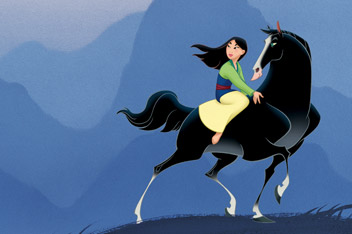
The most obvious example of this is Mulan. Though considered among the princesses, Mulan is in no way royal. She is the daughter of a venerable soldier who chooses to go to war in her father’s stead so she can save his life by cross-dressing as his son instead. Her act of courage allows her to not only rescue her father, but all of China from the Hun’s as well, while proving herself as an able warrior despite the restrictions put on her by gender roles in society. Of all the Disney films, Mulan most directly challenges the gender stereotypes of the previous fairy tale princess by giving their lead character authorship of her own destiny. While there is a love story involved, Mulan is the take-charge heroine of the twenty-first century. Funny then that, when in advertisements, she is always depicted among the other Disney princesses in the delicate gown she’s forced into at the beginning of the film rather than her armor. Even in her success as an Anti-Princess, Mulan is still forced into the ‘pretty dress/delicate flower’ convention that most of her film stands against.
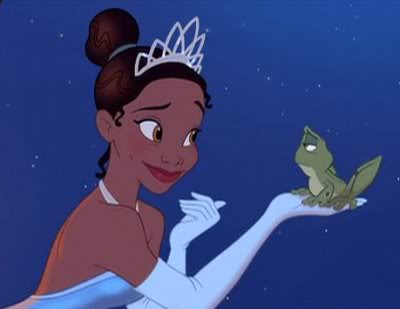
Another good example of a modernized, take-charge non-princess is Tiana of The Princess and the Frog. Tiana is the perfect case of a normal, working class woman given the chance to step up and make all her dreams come true through the liberal application of hard work, determination and a little magic. Yet her anti-princess status is ruined as Tiana is still part of the usual ‘someday my prince will come’ story arc reserved for most of the princesses in the line-up. The fact that she gets the man of her dreams and her resteraunt at the end of her film is an indication that modern princesses seem to be allowed to achieve their own goals outside of relationships.
In the end, at least Mulan and Tiana still get top billing among the Princess Pantheon. There are other Disney heroines who got left off the roster, who might have been left behind by virtue of their saucy attitude and not-quite-so wholesome appeal.
Morally Questionable Anti-Princesses—Megara, Esmeralda
Two women who were left out of the Disney Princess Pantheon are interesting case studies in how to craft a movie heroine. They present some moral questions in their storylines that can make an audience wonder exactly how child-friendly their stories are. For that reason, I believe, they remained off the Princess List. Those two women are The Hunchback of Notre Dame‘s Esmeralda and Hercules‘ Megara. While Mulan and Tiana were added to the Princess Line-Up despite having no royal pedigree, these two women are examples of some creative editing due to where they find their particular power in the films: through blatant uses of sexuality.
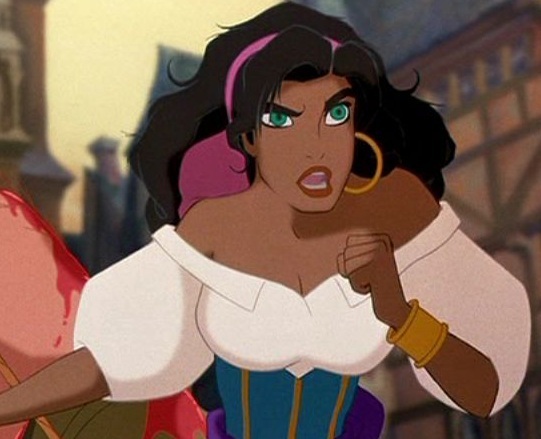
Disney’s Hunchback has always rang as a film with a few too many adult themes for the kid-friendly company to handle. When Esmeralda dances across screen to tease and titulate Judge Claude Frodo, she is an independent woman using her sexuality in a comfortable sort of way. She similarly has no problem showing confidence and sass when dealing with her love interest, Phoebus, something most Disney Princess rarely use. Here is a woman with the power in her relationships and, despite her status as eventual damsel in distress once more, Esmeralda is a difficult character to include in a squeaky clean line-up of wide-eyed waifs. Yet when you consider Esmeralda, is she any less concerned with her people and injustice than, say, Pocahontas? It is her blatant sexuality that sets her apart, and also makes her the focus of perhaps the only sexual harrassment plotline done by Disney.
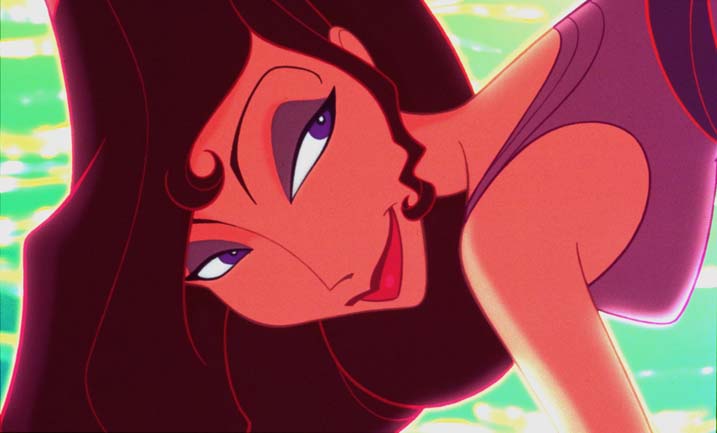
Esmeralda’s in good company when you consider that Hercules‘ love interest, Megara, isn’t anywhere near the Disney Princess line-up either. This snarky redhead lit up the screen in the Greek myth adaptation, providing audiences with a conflicted heroine torn between betraying the man she’s falling in love with and being ripped up by her former boss, Hades. Megara is a complicated woman whose heart and loyalty, though torn throughout the film, are entirely her own. She is sexy and knows it, and that once again makes her a difficult character for the PG brand. Yet in the pantheon of Anti-Princesses, like Esmeralda, she claims her place among the more in command, take-charge Disney women. When she finally does give in to her feelings for Hercules, it is after a lot of soul-searching and character growth, something that could be a good story for young women to learn—if she was given the same air time as the other Disney heroines.
Enter Merida—Inheritor of the Princess Legacy
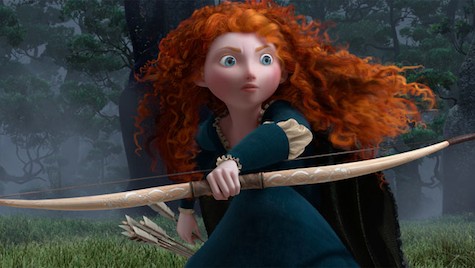
After years of various princesses and their legacies, now comes Merida of Brave. In Brave, audiences are presented with the ultimate Anti-Princess without the baggage, the evolution of every female role-model perfectly designed to combat the ‘Prince Charming’ trap of the earlier fairy tales. Merida’s story is a clarion call, a post-modern restructuring of the Disney legends, out to present a different option for little girls. She isn’t a princess out to sing to little birdies or worry about her prince coming to rescue her. Merida shoots arrows and takes action to defend herself, makes mistakes and works to change them like a mature young woman. She battles for her independence against what she deems unfair, all while learning important lessons about diplomacy, respect for tradition, and communal responsibility.
Oh, and in case we needed more, she’s also shown doing all the responsible things a daughter should do in her family. She mucks out stalls as part of her job and learns her lessons, answers to her parents and worries about her family, all like any other normal kid. This is no dainty little girl in silks, but someone capable of getting into the thick of things to sort out a problem and willing to press the issue until she gets what she needs out of life. In essence, Merida is the inheritor of the iron will and personal power of the Disney Anti-Princesses before her, presented in a more palatable package, a role model for little girls that can transcend the reliance on marriage as the only good solution once and for all. I’m intrigued to see if Merida will be included in the Disney Princess Line-Up in all her modern glory, or relegated to a category all her own, separated by her non-paired status as a single and content girl of her own.
Shoshana Kessock is a comics fan, photographer, game developer, LARPer and all around geek girl. She’s the creator of Phoenix Outlaw Productions and ReImaginedReality.com.










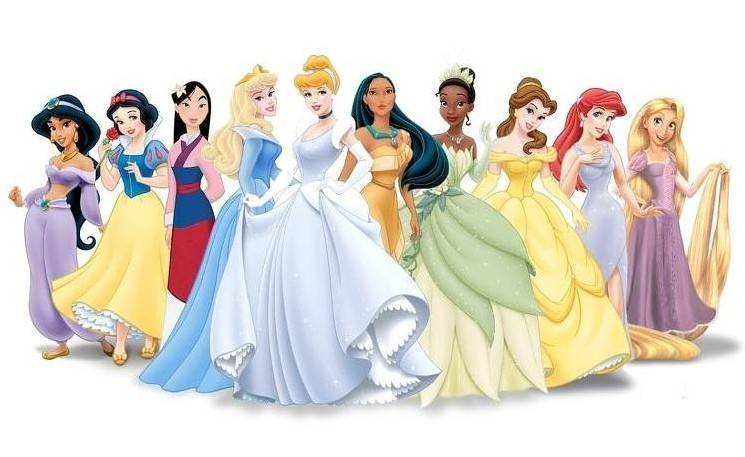
As the mother of a son, I really hope his future bride is much more like
Merida and less Snow White.
I’m sorry, get up a do for yourself sweetheart.
Thank You very much for this article!
I love that you put Mulan and Megara in the limelight – I always found them better and more likeable characters than the more traditional princesses. Maybe because they are not perfect, and therefore they can develop as characters. Both of them are on a quest to find themselves.
Mulan was always quite resourceful, but she had a hard time to fit into the society – first she had to discover herself. And pretending to be a male soldier was not the solution, only a part of her journey – she sucked, when she tried to be way more feminine or masculine than her true self, or, in other words, when she tried to fulfil others expectations and did not act like herself. Compare the debacle with the match-maker and the one with the soldiers on her first day. One of Mulan’s virtue is thinking outside of the box (she can repel the hun attack because of this), and the message is the film is find yourself and be true to it. There are people who think that the message is ‘being more masculine help’, which is simplistic and untrue – hey, she even defeat Shan Yu with a fan! (And needless to say, she changed her male peers preconceptions about gender stereotypes.)
As for Megara, despite when we first meet with her, she refers herself as a Damstrell in Distress, she actually saves her love’s life before he would – and she does not do it for popularity or prize or because the code of heroes says so (which motivates Hercules until this point), but out of selfless love. Actually, both Meg and Herc help each other during their character growth. And it is her, who shows first that she really would sacrifice her life – in fact, she does – out of love, not Hercules.
Because she’s my favorite proper princess, I want to say Jasmine has shades of this, although not to the extent of the ladies featured here; she’s pretty aware of the power and problems her sexuality has in the society she lives in, from telling her dad, Jafar, and Aladdin off for treating her like a object to, like my beloved Esmeralda, using her sexuality as a weapon (although it’s much more awkward on her, and, hmm, Disney, the only women who use their sexuality are women of color? HMM?). And her relationship with Aladdin is less reward-based for either of them and more based on the fact that they understand each other really well.
In conclusion, Esmeralda is the bomb.
An excelent article, and well thought out.
I do have to say that I think there’s a different reason why Kida, Esmeralda and Megara are left off the Princess list. It’s not because of their personality, it’s because their movies were not branded as Princess movies. Their movies were “boy” movies, with male protagonists. So, while they were strong women characters, with stories of their own, the movie itself was not their story, and they were not the main character. Thus, not part of the Princess brand.
I’m also of the opinion that Merida will not be part of the brand, either, because she comes from a Pixar film, and not a strictly disney one. It’s a matter of branding, a marketing viewpoint, rather than any kind of stance of feminisim or worthieness of the characters.
Just my two cents.
Disney barely acknowledges the existence of Atlantis at all, princess or otherwise. I think it falls into the same crack as Treasure Planet as ‘underperforming experiment in animation aimed at boys’. The movie got crushed by Shrek in the year of its release and kind of withered on the vine. There was supposed to be a tv show and a ride, but both were canceled when the movie tanked. It shows up on the Disney Channel once in a while, which is how I’ve seen it, but I think that’s all the Disney promotion/merchandising I’ve ever seen for it in the years since its release. I’m sure if the movie had done much better and there’d been the tv show, Kida probably would be in the princess line, but it’s now to the point of “Kida who?” But maybe there’ll be a resurgence, since I saw that the BluRay is coming out this fall and that’s always accompanied by a marketing blitz.
Well, Kida doesn’t get included because her movie was a flop and no one would recognize her. (And kids have become really, really bad at recognizing the characters. I once watched a Wendy at Disneyland refuse to sign autographs for a couple of kids who had no idea who she was. Their parents didn’t either.) The addition of a heroine to the standard princess lineup is because of the popularity of her movie, not because of how well she fits a desired message.
The toy merchandising has a lot more to answer for than the movies. Almost all of the newer movies have at least some good examples. Belle and Jasmine have great moments of cunning and bravery. Ariel’s more of a silly litle girl, but she does fight for what she wants. The hardest to defend are Snow White, Cinderella, and Sleeping Beauty, the newest of which was released in 1959. Of course those are the ones my 3-year-old daughter is obsessed with.
I barely remember Atlantis either, but if Wikipedia is to be believed, it should be out again this year.
Belle doesn’t become a princess until the ending of her movie .
She’s a bookworm. And she rocks.
Don’t forget Alice and Lilo!
I think you (and a lot of other people) are being too harsh in your assessment of the princess franchise as a whole. You left off a lot of strong heroines who do make independent decisions. Jasmine refuses to marry the idiots her father pushes on her, calls Aladdin out when he lies to her, and nearly saves them in the end before being ensorcelled by Jafar. Belle likes books, thinks for herself, and braves dangers to save her father. Ariel makes some poor decisions, but at least she’s trying to act on her dreams. And you’re not even going to mention Rapunzel?
I don’t think we should teach girls to just sit around waiting for their dream husband to show up, but it seems to me that every single princess since Cinderella takes an active role in pursuing her dreams, which usually includes both a “true love” and some other goal like saving her family or country, or getting to travel somewhere outside of her ordinary experience. It’s good that we now have female role models who are less interested in romance, but the fact is that many girls adore love stories, and there’s nothing wrong with that either.
Thanks for this thoughtful and interesting article!
I think it’s important to note the influence that toys and merchandising have in the creation of the Disney princess brand – very few of the movies from Aladdin onwards have female characters that are nearly as problematic as critics seem to think. Even Rapunzel, not included here, is a far more dynamic heroine than the early princesses who, we must remember, were created in some cases over 50 years ago.
But the toys. Oh, the toys. As you note, the complex and interesting messages portrayed by films such as Mulan are often erased in favour of a bland, “pretty” version of the character. As a mother of small children I have to say I have a whole lot less of a problem with Disney movies than I do with the images presented by the products they sell in toyshops.
Merida, for instance, is currently represented by two dolls in the Disney princess section. One has a horse, one does not. Know what’s missing? HER BOW. The most iconic, character-relevant prop of her story is not represented, even as an illustration on the packaging. Likewise, Rapunzel of Tangled is generally represented in plastic with a comb and brush as her props, not the saucepan she wields with valiant strength for most of her movie. On the toy shelf, she is reduced to being a girl who has to look after her hair, not a girl who goes on adventures.
Once you see this stuff, you can’t unsee it. It’s not restricted to Disney princesses, either. Toy designers, manufacturers and marketers are imposing far more disturbing gender binaries on our children than are the creators of the TV and movies that they are based on – even when the TV shows and movies are problematic, gender-wise, you can guarantee that the merchandise will be ten times worse.
PS: Megara is my favourite, I would buy my daughter a doll based on her in a hot second. Moral ambiguities for the win!
@10, I think it’s important to draw distinctions between the Disney Princess characters in their respective films and the way they’re packaged in the Princess marketing franchise. While the female leads may take an active role (to a lesser or greater extent) in their stories, the Princess franchise reduces them to pretty dresses and appropriate accessories, all of which can be handily purchased for your little princess to wear herself. (Peggy Orenstein’s book “Cinderella Ate My Daughter” has some good chapters dealing with this exact topic.) Mulan is a great example–while she’s an empowered, totally kickass heroine in the film, her Princess franchise incarnation focuses on the pretty dress…which she violently eschews approximately 15 minutes into the film. The official Princess franchise (which I think = Belle, Sleeping Beauty, Cinderella, Snow White, Mulan, and Tiana) reduces its otherwise strong female characters to the passivity levels of its three most boring leading ladies: Cinderella, Snow White, and Sleeping Beauty. incidentally, they have the most marketing opportunities for elaborate dresses, so this makes sense.
I commend Disney for having a range of female characters with different goals and different methods of achieving them. (And it’s great that those goals include both “finding true love” and “saving China.”) But it’s too bad the Princess marketing juggernaut is selling such boring and reductionist narratives, especially when they have much stronger original content.
I’ve always wondered why Nala is never included in the princess line. I don’t think we ever see her parents, but she’s certainly betrothed to the prince from a very young age, which makes her as much of a princess as half the current line. And when times get tough for her family, does she skip town, like her boyfriend? Heck no! She stays around and does the hard work. Until things get really desperate, and then she’s the one who goes out on her own to get help. Seems like a pretty strong role model to me. Is it because she doesn’t have long, brushable hair?
What everyone on this thread seems to be trying to say but not quite getting to is that there is a GIGANTIC divide at Disney between the work that gets done in Feature Animation and the way it gets bastardized at Marketing. If you actually watch the films in question, it’s really up in the air whether Disney has ever actually portrayed the passive, clothing-and-mancatching-obsessed female that all these authors are objecting to. Maybe leave off Snow White as an aberration–it was 1938, for goodness’ sake, and anyway the character is really presented as a child/incarnation of innocence rather than a real person. But Cinderella? She’s disempowered, sure, but she’s a grown woman trying to maintain optimism in the face of emotional abuse and demanding the right to enjoy herself for one night when she gets a document that allows her to do so (watch her composure in the invitation scene). And incidentally, she doesn’t actually know who the Prince is until the next morning, and never intended to see him again. And if you watch Sleeping Beauty, notice that, when Aurora finds out she is a princess and is presented with a ball gown–she runs away, and is literally crowned while catatonic from grief.
The point is that, while the Princess franchise is pernicious and infuriating, one of the most infuriating aspects is how insulting it is to the talents of the original artists. This goes for the visual aspects too. I nearly gag whenever I see the poor draftsmanship on all the Princess merchandise that gives every girl the same utterly vapid expression. That drawing wouldn’t last ten seconds in an animation studio.
Chris@@.-@: Counterpoint: Jasmine. Aladdin was very much a ‘boy’ movie, and her princessness is nonetheless not remotely in question.
My daughter loves the Princesses mostly for the dresses/pretty jewlery and the songs… I dont think marrying prince charming etc. really enters the equation. But I always tell her the best princess IMHO is Princess Leia.. then do my best wookie roar.
The more I look at it, the more I see a wide diversity of ‘princesses’ in the Disney movies, who make a lot of different life choices, and have lots of different personalities. Especially when you include the female characters from the broader spectrum of all Disney movies. And no one has yet mentioned the quite spunky and mechanically inclined Tinkerbelle.
Like TanseyRR says, the cliche of princess as object of affection and clotheshanger for beautiful dresses is more a function of the merchandising arm of the organization than the movie makers. And boy does she hit the nail on the head when she points out that this is a symptom of the toy industry in general. There is draconian segregation of what girls are supposed to like and what boys are supposed to like in the aisles of your local WalMart and Toys are Us.
My granddaughter Meg’s favorite Disney female character is Megara, or at least it was for a long while, and she definitely connected with Rapunzel. Haven’t gotten a chance to talk to her much about Brave yet, although I did get her one of the little dolls (which now that you mention it did come with two dresses and no bow).
(And I don’t want to get off track in this thread, but I would love to talk about Atlantis some more, that was a little bit of steampunk that was well ahead of its time, and vastly underappreciated.)
Well, I can tell you why Kida, Esmerelda, and Meagara aren’t in the lineup–the same reason that Disney would really, really like to pretend that “Treasure Planet” and “The Black Cauldron” never happened. Money. The movies just weren’t popular enough. In the case of “Hunchback” I suspect there’s a certain degree of “I can’t believe someone here thought Victor Hugo would be a good idea for an animated musical.” Between the ‘you know, for kids!’ aspect of “Hellfire” to the stupidly happy ending (Esmerelda and Quasimodo are supposed to DIE and Phoebus is a jerk) it’s kind of embarrassing in retrospect. Hercules wasn’t AS bad a flop but it wasn’t a blockbuster, either-no breakout characters, not very pretty animation.
I always liked Belle. I would happily marry a prince whose idea of a courting gift is an entire library. (It would be nice if it came with a librarian….) Mulan (who’s apparently been toned WAY back from Mary-Sue status compared to the original Chinese legend) is another favorite. I wish I could get past the historian in me as far as Pocahontas goes, but I can’t. Especially not with the direct-to-video sequel.
– Tiana is a princess by marriage at the end of her film (that is how she becomes human again), so she is definitely not a “non-princess”.
– I find it interesting the Princesses that Disney leaves off…Kidagakash, Eilonwy and Nala (and Tiger Lily, but given the racist depiction, it obvious why she doesn’t get a mention). Nala I figure is anthro and not especially good for marketing merchandise. Eilonwy and Kida were in flopped films and I agree that’s the biggest issue with them. Eilonwy was in a (GASP) PG film (Black Cauldron), at that.
– If we’re going to bring up “not princesses” into the discussion based on Mulan’s inclusion, there are plenty more to talk about!
— JANE (Tarzan) was an educated woman who travelled a world away with her father to study apes in the jungle! True, she’s not the most outdoorsy type in the beginning, but she’s a scientist, modern thinker, adventurer, and artist. That’s pretty inspiring.
— LILO and NANI (Lilo & Stitch) are two girls living their life on their own. They’re tough as hell–enough to take on aliens! Lilo is creative and Nani is hard working.
— CAPTAIN AMELIA (Treasure Planet) helms her own space ship. Enough said there, really.
— MISS BIANCA (The Rescuers, The Rescuers Down Under) is prissy as hell, but she still takes charge and saves human children around the world on a regular basis. Even though she’s 5 inches tall.
— ALL THE WOMEN IN ATLANTIS. No, seriously. Kida’s the princess, but Lieutenant Helga Sinclair, Audrey Ramirez, and Wilhelmina Packard are seriously awesome too. Lt. Sinclair might be a touch evil, but she’s a hell of a fighter and all-around bad ass. Audrey is the best mechanic around with some serious punches. Packard is the best there is in radio operation. They all go adventuring into the unknown and take monsters and ship wreck in stride.
What I REALLY want to see is a story line where the main female’s “issue” is NOT MARRIAGE. Merida’s catalyst (and “problem”…though you could argue it’s communcation with mom) is marriage. That’s still disappointing to me. The only Disney gals who don’t have an issue with marriage are children like Lilo or Alice. Everyone else is forced into it: Merida, Poca, Mulan, Nala, Jasmine, etcetcetc. Obsessed with it: Ariel, Snow White, Aurora. Or finds it’s their ultimate destiny (Oh hey, it’s cool you like that other stuff, but isn’t TRUE LOVE the way you should go?): Jane, Capt. Amelia, Kida, Esmeralda, Belle, Rapunzel, etc.
So yeah. I’m NOT saying that love/marriage is not possible with other ambitions. However, most of our society still pushes women to focus on getting married first, and doing other things second. So it’s ANNOYING to not have any marriage-age Disney heroine be okay with being single and/or not having to spend her movie fighting off such pressures. Especially when the bulk of the heroines are 15 or 16. :/ (Or 4. Geez, Nala.)
Interesting conversation. I have two little girls under the age of 6. Princesses are big in my house. From this parent’s point of view, there is so little that is safe. Even some of what goes on in the fairy line is beyond what I would want to expose my 6 year old to, much less her little sister.
And the pricness line is not Dora… so hallelujah for that.
“– CAPTAIN AMELIA (Treasure Planet) helms her own space ship. Enough said there, really.”
And Sarah Hawkins has the willpower not only to maintain single-handedly an inn, but to take care of her problematic son. No wonder, why Doppler respect this virtue of her.
Reading all these comments, which are really informative and interesting, there is one point missing.
Looking at the “non-traditional” Princesses featured here has anyone else noticed the fact that they are all a little more “original” works?
Snow White, Rapunzel, Cinderella, Sleeping Beauty are all Grimm Princesses. They were conceived in a very different time and therefore their stories will of course have goals and morals vastly different than what we today would consider imortant.
Granted, the stories that Mulan and Pocahontas are based are just as old and have certainly been retold in one form or another for even longer, but with them there was some flexibilty. You cannot really change a tale as well known as Cinderella or Snow White too much and still make it a Disney kids movie. I think that is also the reason why, as another commenter also noticed it seem to be the women of colour that are the exceptions to the rule when it comes to using their sexuality to achieve their goals. Their stories were either original or adapted from less well-known tales that afforded the creators a little more creative license. Probably why I also vastly prefer them over the more staid ladies.
Feeling a little contrary this morning….how about the princes who ‘save’ the women in Cinderella, Snow White, Sleeping Beauty? They’re interchangeable, because they aren’t characters at all. The role of Eligible Prince is as worthy of scrutiny in the history of Disney. Beast and Aladdin at least have to be worthy of their babes–and who gets to decide their worthiness? What are the criteria of worthy prince/hero? I think any discussion of the Princesses is incomplete without considering the evolution of the Princes on offer.
Tellingly, the whole discussion makes me want to watch ‘Shrek’ instead of any Disney film listed.
As a man, I have to admit that I don’t understand the princess thing. When I was a boy, I wanted to be the nameless knight. Or a wizard. And sometimes sombody would always want to be king. But nobody, ever, wanted to be the prince. It’s clearly a girl thing, but what is the appeal? I hope it’s not the idea of being free of responsibility. That seems like a horrible…desire to plant. Why not queen. Do anyones daughters ever want to be queens? It’s is admitedly much better to hold the reins.
@23: The whole “boring Prince” issue is really tied up with the evolution of draftsmanship, actually. Historically, animators have found human males to be much harder to convincingly draw and animate than human females. The Prince in Snow White was actually supposed to be a much more involved character at the storyboard level, but at the animation level it just proved impossible to make him look convincing. That’s why you really have to go all the way down to Aladdin to get an attractive human male who can carry a story: decades of experimentation with figuring out the right relationship of “cartoony” to “realistic” drawing.
Do anyone’s daughters ever want to be queens?
@Cleggster: Lucy Van Pelt. I just saw an excellent community theatre production of You’re a Good Man, Charlie Brown, in which one of the set pieces reprises the occasional riff from the comic strip in which Lucy projects herself as Queen, and explicitly as ruler of her own Queendom.
And of course, Lucy is a foil, and annoying. She’s not exactly held up as an exemplar of how to be a perfect little girl. That entire last line is the problem, actually. “How to be a perfect little girl” is a limiting (and entirely unattainable) goal to pound into our children.
My favorite prince was the one from Sleeping Beauty. He fell in love with her not because she was royal, but for herself, meeting her when she was in disguise. And when the witch despoiled the land, he strapped on sword and shield and went on a quest through thorns and to face a dragon in order to save the princess and free the land. Now that was a prince that kicked butt and took names…
Batting eyelashes isn’t the problem, it’s the bowling of eyeballs that’s the problem, according to one of my friends, a solo mother whose boyfriend finally married her – much to her joy.
Okay, getting facetious … it’s also a problem with Mickey Duck and the rest of the Disney population. Mickey Mouse has adventures; Donald Duck has adventures; Minnie doesn’t, etc.
Here’s an idea – modern technology has put animation in the hands of many more possible amateur film director/producers. Some of us have family stories that involve women taking huge risks for family and even nation/state/people. Without being princesses. Just heroines. And sometimes they even get recognized for their heroism.
What’s stopping you from doing unto Disney as Disney seeks to do unto competitors, and wiping the board with them?
(I hate the “pretty-pretty” characterization of females in Disney and in the obscene Beauty Pageants for little girls I’ve occasionally heard exist in the States. Most of the women I’ve grown up around, are tougher than that.)
International Secret Conspiracy for the Oppression of Teddybears
Speaking of merchandise – my daughters were enthralled by princesses when they were younger, but now at the ages of 11 and 8, consider Princesses to be “so yesterday” (actual quote from younger child).
However, they both loved Enchanted and Brave, and the toys acquired to play them have been a frying pan (albeit a pink one) and a bow and arrow set, both from the dollar store (let me think, $20 for a cheap bow and arrow or $1.50?).
@23: Sorry but like 28 pointed out, Prince Phillip (from Sleeping Beauty) rocks! He’s the first one who did anything other than show up!
That is my favorite traditional Disney movie.
I really hated the fact that ATLANTIS even had the stupid “twist” of the crew members being villains including Helga.
It felt really forced or NEEDED at all for the story they were trying to more or less “tell” which was a uneventful action movie and also the crew basically forgets Helga was even with them!?!?.
It was really weird how that was done and as for Kida she was clumsy a plot device for Milo and that EVIL crystal thing in general. It was a mistake on the filmmakers’s part to have something like that for Atlantis if they couldn’t decide what on earth it does or anything like that.
I felt surprisingly that Helga was way more the “princess” character here(who doesn’t get rescued….just because and makes the “heroes” out to be more villainous then ever) then the confusing Kida, maybe because the whole movie never found a right tone for itself once the crew actually reaches Atlantis.
Princess Leia was my idea of a princess. ‘I don’t know who you are, or where you came from but from now on you do as I tell you!’